Best Ocular Surface Squamous Neoplasia (OSSN) Surgery in Malleshwaram – Sapiens Clinic
Ocular Surface Squamous Neoplasia (OSSN) refers to a spectrum of conjunctival and corneal lesions, ranging from mild dysplasia to invasive squamous cell carcinoma. Although often considered a low-grade malignancy, invasive OSSN has the potential to spread across the ocular surface and, in some cases, deeper into the globe or orbit. It is recognized as a malignancy of the conjunctiva and cornea that requires careful evaluation and timely intervention.
At Sapiens Clinic in Malleshwaram, we offer precise diagnosis and expert management of OSSN, backed by advanced diagnostic tools and surgical expertise in oculoplastic care.
Causes and Risk Factors of OSSN
OSSN is influenced by a combination of environmental and genetic risk factors. The most significant among them is prolonged ultraviolet (UV) exposure, which can lead to DNAdamage similar to skin cancers. Patients with genetic conditions such as xeroderma pigmentosa are at higher risk due to their inability to repair DNA mutations caused by UV radiation.
Other contributing factors include :
- Human Papilloma Virus (HPV) infection
- HIV and other causes of immunosuppression
- Chronic exposure to petroleum products
- Smoking
- Older age, male gender, and fair skin tone
Diagnosis of OSSN
Diagnosing OSSN involves a detailed clinical evaluation of the lesion’s appearance, size, location, and extent. Additional assessments may include :
- Gonioscopy – to evaluate angle involvement
- Dilated fundus examination – to check intraocular spread
- Ultrasound B-scan – useful when media opacity obstructs view
- CT or MRI imaging – to assess orbital or anterior segment involvement
- Regional lymph node examination – particularly preauricular and submandibular nodes
However, the most definitive diagnosis comes through histopathological examination, done via incisional or excisional biopsy. This helps differentiate between intraepithelial and invasive disease, which is critical for planning treatment.
Treatment Options for OSSN at Sapiens Clinic
Treatment for OSSN depends on the size, location, and invasiveness of the lesion and may be surgical, non-surgical, or a combination of both.
Non-Surgical Options
Topical therapies are often used in small or superficial lesions :
- Mitomycin-C
- 5-Fluorouracil (5-FU)
- Interferon Alpha 2b
These medications are effective in treating abnormal ocular surface cells without surgery. However, consistent compliance over weeks or months is necessary for success.
Surgical Treatment
Surgical excision remains the primary approach for larger or more aggressive OSSN cases. At Sapiens Clinic, we follow the “No-Touch” technique which minimizes the risk of tumor seeding and ensures a clean margin of healthy tissue.
Key steps include :
- Use of local anesthesia and vasoconstrictors to reduce bleeding
- Accurate mapping and resection of the tumor with 4-mm safe margins
- Cryotherapy to the scleral bed to destroy residual malignant cells
- Use of amniotic membrane transplant with fibrin glue (not sutures) to reduce inflammation and promote healing
When the cornea is involved, alcohol epitheliectomy is performed to remove affected epithelium, followed by careful management of the corneal surface.
Why Choose Sapiens Clinic for OSSN Surgery in Malleshwaram?
At Sapiens Clinic, we prioritize precision and patient safety. Our oculoplastic surgery team is experienced in handling delicate ocular tumors like OSSN. We utilize evidence-based practices, advanced imaging, and surgical protocols to ensure effective tumor removal with minimal recurrence.
From diagnosis to post-operative recovery, we offer comprehensive, compassionate care right here in Malleshwaram.
OSSN Surgery Cost in Malleshwaram
The cost of OSSN treatment at Sapiens Clinic is determined based on :
- The extent of the lesion
- Type of treatment (medical vs. surgical)
- Diagnostics and imaging
- Post-operative care and medications
For a precise estimate, we recommend an in-clinic consultation, where our specialists can evaluate your condition and recommend a personalized treatment plan.
FAQs
1. What is Ocular Surface Squamous Neoplasia (OSSN)?
OSSN refers to a group of eye surface tumors that range from pre-cancerous lesions to invasive squamous cell carcinoma affecting the conjunctiva and cornea. It may appear as a white or reddish mass on the eye surface and can lead to discomfort, vision changes, or even eye damage if not treated.
2. Is OSSN a type of eye cancer?
Yes, OSSN is considered a low-grade malignancy. While many cases are localized and treatable, some invasive forms can spread deeper into the eye socket and may require more extensive management.
3. What causes OSSN?
The primary risk factors include excessive exposure to UV radiation, HIV or HPV infections, genetic conditions like xeroderma pigmentosa, and immunosuppression. People with fair skin and those living in sunny regions are more prone to developing it.
4. How is OSSN treated?
OSSN is treated either through topical chemotherapy (using eye drops like Mitomycin-C or Interferon Alpha 2b), surgical excision with a “no-touch” technique, or a combination of both. The treatment approach depends on the size, depth, and location of the lesion.
5. Can OSSN come back after treatment?
There is a possibility of recurrence, especially if the lesion was large or incompletely excised. Regular follow-ups and surface surveillance are essential to detect and manage any signs of recurrence early.

Leave a Reply